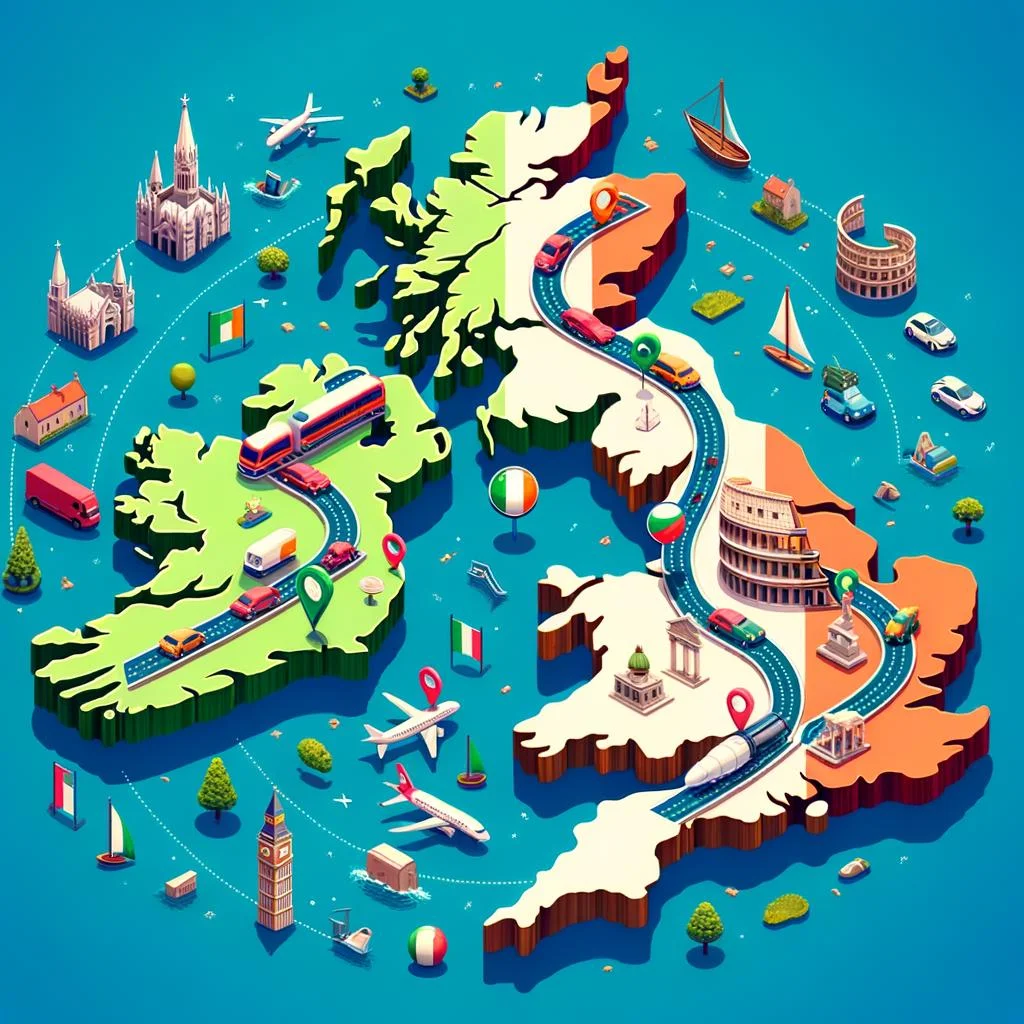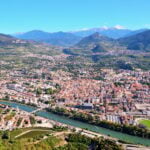Traveling from Ireland to Italy may seem like a daunting task, but with the right information and tips, it can be an exciting journey filled with adventure and new experiences. Whether you’re looking to explore the historical wonders of Rome, indulge in the culinary delights of Tuscany, or simply soak up the sun along the Amalfi Coast, there are several transportation options to consider when making your way from the Emerald Isle to the land of pizza and pasta.
When planning a trip from Ireland to Italy, it’s important to weigh the pros and cons of various modes of transportation. From convenient flights that offer speed and efficiency to scenic train rides that provide a different perspective of Europe’s landscapes, as well as the unique experience of sailing across the Mediterranean Sea on a ferry, each option offers its own set of advantages and charms.
In this article, we will explore these transportation options in-depth and provide valuable insights for planning your journey.
In this section, we’ll delve into each transportation option available for traveling from Ireland to Italy. Whether you prefer the convenience of flying or are interested in a more leisurely travel experience by train or ferry, we will compare these options and offer tips for finding the best routes, schedules, and cost-effective ways to make your way across countries.
So sit back, relax, and let us guide you through all there is to know about traveling from Ireland to Italy.
Transportation Options
When planning a trip from Ireland to Italy, one of the first things to consider is how you will travel between the two countries. With several transportation options available, it’s important to compare flights, trains, and ferries to determine the best choice for your journey. Each mode of transportation offers its own advantages and considerations, so let’s take a closer look at each option.
1. Flying from Ireland to Italy:
Flying is often the fastest and most convenient way to travel from Ireland to Italy. With numerous airlines offering direct and connecting flights, travelers have a variety of options when it comes to choosing their departure and arrival airports.
For those looking for budget-friendly options, low-cost carriers can provide affordable fares, especially if booked in advance. When flying from Ireland to Italy, major airports such as Dublin Airport, Shannon Airport, Rome Fiumicino Airport, and Milan Malpensa Airport are popular choices for travelers.
2. Taking the train:
For those who prefer a scenic journey with the added convenience of city-center arrivals, taking the train from Ireland to Italy may be a great option. While there are no direct train routes connecting the two countries, travelers can take advantage of high-speed rail services within Europe to reach Italian cities like Milan or Rome from major train stations in France or Switzerland.
3. Sailing the seas:
Another unique option for traveling from Ireland to Italy is by ferry. While not as fast as flying or as convenient as taking the train, sailing across the water can offer a more leisurely and immersive travel experience. There are several ferry routes available that connect ports in Ireland with destinations along the Italian coast, allowing travelers to bring their vehicles or enjoy onboard amenities during the journey.
By comparing flights, trains, and ferries for your journey from Ireland to Italy, you can determine which transportation option best suits your preferences and travel plans. Whether you prioritize speed, convenience, or adventure, each mode of transportation offers its own unique benefits for experiencing a memorable trip between these two beautiful countries.
Flying From Ireland to Italy
When it comes to traveling from Ireland to Italy, flying is often the most convenient and fastest option. There are several airlines that offer direct flights from major airports in Ireland to popular destinations in Italy.
Aer Lingus, Ryanair, and Alitalia are among the best airlines for this route, offering a variety of flight options to suit different budgets and schedules. Departing from Dublin Airport, Shannon Airport, or Cork Airport provides easy access to various cities in Italy such as Rome, Milan, Venice, and Florence.
For travelers considering how to travel from Ireland to Italy by air, it is essential to consider factors such as baggage allowance, in-flight amenities, and overall travel experience. Comparing prices and available routes can help find the best deals and most convenient options. Additionally, booking flights well in advance can result in significant cost savings.
Before booking a flight from Ireland to Italy, it’s important for travelers to be aware of any travel restrictions or entry requirements due to their nationality or residency status. This may include obtaining a visa or providing negative COVID-19 test results before departure. Keeping up-to-date with current travel regulations can help avoid any last-minute issues when flying internationally.
| Flight Option | Major Airports |
|---|---|
| Aer Lingus | Dublin Airport |
| Ryanair | Cork Airport |
| Alitalia | Shannon Airport |
Taking the Train
When it comes to traveling from Ireland to Italy, taking the train is a unique and scenic option that allows travelers to experience the diverse landscapes of Europe. With a combination of international routes and domestic connections, traveling by train offers a convenient way to explore multiple destinations along the way.
International Routes
There are several options for train travel from Ireland to Italy, with popular routes including connections through France or the United Kingdom. For example, travelers can take a train from Dublin to London and then transfer to the Eurostar, which will take them through the Channel Tunnel to Paris. From there, they can catch a high-speed train to Milan or other Italian cities.
Schedules and Travel Tips
When planning a train journey from Ireland to Italy, it’s essential to consider the schedules and connection times between different trains. It’s advisable to book tickets in advance and allow for sufficient transfer time between trains. Additionally, travelers should be aware of any visa requirements or border controls when traveling through different countries.
Scenic Views
One of the highlights of traveling by train from Ireland to Italy is the opportunity to witness breathtaking scenery along the way. From rolling hills and countryside views in France to stunning alpine landscapes in Switzerland, train passengers can enjoy picturesque vistas as they make their way towards Italy. This mode of transportation provides a relaxing and immersive way to appreciate the beauty of Europe during the journey.
Overall, taking the train from Ireland to Italy offers an enriching travel experience that allows passengers to witness diverse landscapes while conveniently connecting various destinations. By considering international routes, schedules, and enjoying scenic views along the way, travelers can embrace a unique adventure while making their way towards their Italian destination.
Sailing the Seas
Sailing from Ireland to Italy can be a unique and enjoyable way to travel, offering a different perspective and experience compared to flying or taking the train. There are several ferry options available for those seeking to cross the water between these two countries, each with its own set of amenities, schedules, and routes.
One popular ferry option is the route from Dublin, Ireland to Cherbourg, France, which can then connect travelers to various cities in Italy. This route is often taken by those looking for a more scenic and leisurely journey, as it allows passengers to enjoy the stunning views of the Irish Sea and the English Channel. Another popular ferry route is from Rosslare, Ireland to Roscoff, France, which also provides access to Italy once on land.
Travelers looking for a faster ferry option can consider the direct route from Cork, Ireland to Roscoff or from Cork to Santander, Spain. While these routes may not offer as much time at sea as other options, they still provide a relaxing and comfortable way to travel from Ireland to Italy without having to board a plane or train.
When considering taking a ferry from Ireland to Italy, it’s important for travelers to research and compare different ferry companies based on factors such as prices, onboard accommodations, travel duration, and departure schedules.
| Ferry Route | Travel Duration |
|---|---|
| Dublin – Cherbourg | Approximately 18 hours |
| Rosslare – Roscoff | Approximately 17 hours |
| Cork – Roscoff | Approximately 14 hours |
| Cork – Santander | Approximately 26 hours |
Planning Your Itinerary
When planning a trip from Ireland to Italy, it’s important to consider the must-see destinations and attractions in Italy. Whether you’re interested in historical landmarks, breathtaking landscapes, or delicious cuisine, Italy has something for everyone. Here are some top destinations to include in your Italian itinerary:
- Rome: As the capital city of Italy, Rome is rich in history and culture. Don’t miss iconic attractions such as the Colosseum, Roman Forum, and Vatican City.
- Florence: Known for its Renaissance art and architecture, Florence is a must-visit for art enthusiasts. The Uffizi Gallery, Duomo, and Ponte Vecchio are just a few of the city’s highlights.
- Venice: Explore the romantic canals and historic palaces of Venice. Take a gondola ride along the Grand Canal and visit St. Mark’s Basilica for a truly unforgettable experience.
- Amalfi Coast: For stunning coastal views and charming villages, head to the Amalfi Coast. Positano, Ravello, and Amalfi town offer picturesque landscapes and vibrant Mediterranean culture.
In addition to these well-known destinations, consider adding some off-the-beaten-path locations to your itinerary. Tuscany’s rolling countryside, the ancient ruins of Pompeii, and the colorful villages of Cinque Terre are just a few examples of hidden gems in Italy.
Ultimately, the best way to plan your Italian itinerary is to research each destination’s unique attractions and choose those that align with your interests. Whether you prefer cosmopolitan cities or peaceful rural settings, Italy offers a diverse range of experiences for travelers to enjoy.
Budget Travel Tips
When traveling from Ireland to Italy on a budget, there are several tips and tricks that can help you save money on transportation and accommodation. By making wise choices and planning ahead, you can make the most of your travel budget and still experience all the beauty and excitement that Italy has to offer.
Booking Flights in Advance
One of the best ways to save money on transportation from Ireland to Italy is by booking your flights in advance. Keep an eye out for special deals and promotions from airlines that fly this route. Additionally, consider flying into alternative airports or using budget airlines to find the most economical options for getting to Italy.
Exploring Train Pass Options
For travelers who enjoy scenic views and want a more leisurely journey, taking the train from Ireland to Italy can be a cost-effective option. Consider looking into rail passes or multi-journey tickets that offer discounts for multiple trips within Italy. By doing so, you can save money while enjoying the stunning landscapes as you travel across the country.
Accommodation Choices
When it comes to finding affordable accommodation in Italy, consider staying in hostels or guesthouses instead of expensive hotels. Look for lodging options in less touristy areas or opt for accommodations with shared facilities to stretch your travel budget further. Additionally, consider booking accommodations in advance to secure better rates and availability.
By following these budget travel tips, you can make the most of your journey from Ireland to Italy without breaking the bank. With careful planning and smart choices, you can enjoy all that Italy has to offer while staying within your travel budget.
Conclusion
In conclusion, traveling from Ireland to Italy offers a variety of transportation options, each with its own unique advantages and experiences. Whether you prefer the speed and convenience of flying, the scenic views and relaxed pace of train travel, or the adventure of sailing across the sea, there are multiple ways to make the journey between these two beautiful countries.

When flying from Ireland to Italy, it is important to consider factors such as the best airlines and airports for your specific itinerary. Researching travel tips and booking in advance can help ensure a smooth and pleasant flight experience. Alternatively, taking a train provides an opportunity to appreciate the breathtaking scenery along the way while experiencing a more leisurely form of travel.
For those seeking a more adventurous and memorable journey, ferry options offer a unique way to traverse the distance between Ireland and Italy. While sailing may take longer than flying or taking a train, it provides an opportunity to relax on board while enjoying stunning views of the open sea.
Ultimately, when planning your trip from Ireland to Italy, it’s essential to consider your budget and preferred mode of travel in order to make the most informed decision. By incorporating budget-friendly tips for transportation and accommodation, travelers can enjoy a seamless and unforgettable experience exploring everything Italy has to offer after making their way from Ireland.
Frequently Asked Questions
How Do I Get From Ireland to Italy?
To get from Ireland to Italy, you can either fly or take a combination of trains and ferries. The most popular option is to fly from Dublin to one of the major airports in Italy, such as Rome, Milan, or Venice.
How Far Is the Train Ride From Ireland to Italy?
Since there is no direct train route from Ireland to Italy, the train ride distance doesn’t apply. However, if you were to take the Eurostar and other connecting trains, the total travel time would be around 24-28 hours depending on the connections.
Can I Travel From Italy to Ireland by Train?
It’s not possible to travel directly from Italy to Ireland by train due to the geographical barrier of the sea. However, it is possible to take a train from Italy to France or England and then use a ferry or plane to cross the remaining distance to Ireland.

I’m a passionate traveler, writer, and Italophile. My fascination with Italy’s history, art, and culture has led me on countless adventures across the Italian landscape. Through “I Live Italy,” I share my love for this extraordinary country and aims to inspire others to explore its boundless beauty.





